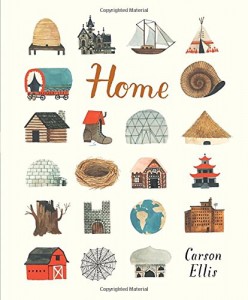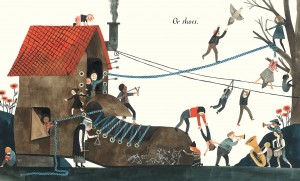February 27, 2015
Home by Carson Ellis
 While Carson Ellis’ Home is a beautiful book, it first appealed to me conceptually for its similarity to one of my favourite picture books, A House is a House for Me by Mary-Ann Hoberman and Betty Fraser, published in 1978. Both books—with whimsy, strange and gorgeous illustrations (plus a Duchess)—explore the variousness of dwellings, and the curiousness too; from the Hoberman book, “A box is a house for a teabag. A teapot’s a house for some tea. If you pour me a cup and I drink it all up, Then the teahouse will turn into me.” All this to the point where I opened by Ellis’ book, and wondered where were the rhyming couplets.
While Carson Ellis’ Home is a beautiful book, it first appealed to me conceptually for its similarity to one of my favourite picture books, A House is a House for Me by Mary-Ann Hoberman and Betty Fraser, published in 1978. Both books—with whimsy, strange and gorgeous illustrations (plus a Duchess)—explore the variousness of dwellings, and the curiousness too; from the Hoberman book, “A box is a house for a teabag. A teapot’s a house for some tea. If you pour me a cup and I drink it all up, Then the teahouse will turn into me.” All this to the point where I opened by Ellis’ book, and wondered where were the rhyming couplets.
But Ellis’ project with Home is something that’s different, more art-focused than text-focused, and the text itself seeking to open up the book rather than nailing it down, asking questions like, “But whose home is this?” of a home on the edge of a cliff, “And what about this?” of a tiny home underneath a mushroom—a vaguely Alice-ish reference (which gives this book another point in common with Hoberman’s, in addition to a thing for teacups).
 So I sat down with my children and we started to look at the book, delighting in the illustrations (which will appeal to anyone who likes Jon Klassen’s work, which is everyone), and the oddities. Sure, homes are boats and wigwams, but what IS going on in that underground lair, and how strange to have “French homes” on a page with the inhabitants of Atlantis (whose homes are, naturally, underwater).
So I sat down with my children and we started to look at the book, delighting in the illustrations (which will appeal to anyone who likes Jon Klassen’s work, which is everyone), and the oddities. Sure, homes are boats and wigwams, but what IS going on in that underground lair, and how strange to have “French homes” on a page with the inhabitants of Atlantis (whose homes are, naturally, underwater).
Homes on the moon, in a geodesic dome in space, the home of a Norse god, a castle in a fish bowl (with the knights riding sea-horses), “A babushka lives here,” “A raccoon lives here.” The strange juxtaposition of the bizarre and familiar—it’s a weird and wonderful book that invites even more questions than those the text poses.
 But then we started noticing other things—there is a pigeon on every page, and the same teacup recurs every little while, and there’s a monkey on the ship, and on the shoe-home page, there is a little boy on the roof who’s pulled down his pants, and he’s showing us him bum, and the children were howling. We still couldn’t find the pigeon on the “Bee homes” (though it dawns on me that it’s a wasp’s nest, but I digress) page, so we called in back-up and read the whole book for perhaps the fifth time, in the presence of Daddy. The book was so wholly engaging for the entire family, and we all of us loved it at once.
But then we started noticing other things—there is a pigeon on every page, and the same teacup recurs every little while, and there’s a monkey on the ship, and on the shoe-home page, there is a little boy on the roof who’s pulled down his pants, and he’s showing us him bum, and the children were howling. We still couldn’t find the pigeon on the “Bee homes” (though it dawns on me that it’s a wasp’s nest, but I digress) page, so we called in back-up and read the whole book for perhaps the fifth time, in the presence of Daddy. The book was so wholly engaging for the entire family, and we all of us loved it at once.
“An artist lives here.” is the book’s second-to-final image, showing a person at work in her studio, a room filled with fascinating and ordinary objects all of which (or nearly all of which?) are found within the other pages in the book—a shoe on the floor (sans bum), the fish bowl, stripy socks. And also sketches of the actual illustrations tacked up to the wall, giving the story a new puzzle along with a metafictional subtext, as well as underlining the message that creative inspiration—even for imaginative journeys to the farthest reaches of the universe—can be found in the ordinary world all around us. Which is certainly a testament to the nature of home, indeed.






Oooh…I think I’m going to like this book, Kerry!
For some reason I thought this post was going to be about this book: http://blogs.independent.co.uk/2015/01/30/friday-book-design-blog-here/
Now I need them both.
Oh I must find a copy of this! Thanks, Kerry.